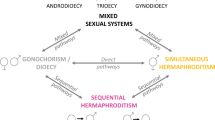Abstract
DARWIN1 believed that sexual selection accounts for the evolution of exaggerated male ornaments, such as the sword-like caudal fin extensions of male fishes of the genus Xiphophorus, that appear detrimental to survival. Swordtails continue to feature prominently in empirical work and theories of sexual selection; the pre-existing bias hypothesis has been offered as an explanation for the evolution of swords in these fishes2,3. Based upon a largely morphological phylogeny, this hypothesis suggests that female preference to mate with sworded males arose in ancestrally swordless species, thus pre-dating the origin of the sword itself and directly driving its evolution. Here we present a molecular phylogeny (based on mitochondria! and nuclear DNA sequences) of Xiphophorus which differs from the traditional one: it indicates that the sword originated and was lost repeatedly. Our phylogeny suggests that the ancestor of the genus is more likely to have possessed a sword than not, thus questioning the applicability of the pre-existing bias hypothesis as an explanation for the evolution of this sexually selected trait.
Similar content being viewed by others
References
Darwin, C. The Descent of Man, and Selection in Relation to Sex (Murray, London, 1871).
Basolo, A. L. Science 250, 808–810 (1990).
Basolo, A. L. Science 253, 1426–1427 (1991).
Bradbury, J. W. & Anderson, M. B. (eds) Sexual Selection: Testing the Alternatives (Wiley, Chichester, UK, 1987).
Maynard Smith, J. in Sexual Selection: Testing the Alternatives (eds Bradbury, J. W. & Anderson, M. B.) 9–20 (Wiley, Chichester, UK, 1987).
Maynard Smith, J. Trends Ecol. Evol. 6, 146–151 (1991).
Kirkpatrick, M. & Ryan, M. J. Nature 350, 33–38 (1991).
Endler, J. A. Am. Nat. 139, S125–S153 (1992).
Kirkpatrick, M. in Sexual Selection: Testing the Alternatives (eds Bradbury, J. W. & Anderson, M. B.) 67–82 (Wiley, Chichester, UK, 1987).
Ryan, M. Oxf. Surv. Evol. Biol. 7, 157–195 (1990).
Ryan, M. J., Fox, J. H., Wilczynski, W. & Rand, A. S. Nature 343, 66–68 (1990).
Alcock, J. Animal Behavior 5th edn (Sinauer, Sunderland, 1993).
Krebs, J. R. & Davies, N. B. An Introduction of Behavioral Ecology 3rd edn (Blackwell, Oxford, 1993).
Ryan, M. & Rand, A. S. Phil. Trans. R. Soc. B 340, 187–195 (1993).
Rosen, D. E. Bull. Am. Mus. nat. His. 162, 268–375 (1979).
Rauchenberger, M., Kallman, K. D. & Morizot, D. C. Am. Mus. nat. His. Nov. 2975, 1–41 (1990).
Haas, V. in Trends in Ichthyology (eds Schröder, J. H., Bauer, J. & Schartl, M.) 279–288 (Blackwell, London, 1993).
Basolo, A. L. Anim. Behav. 40, 332–338 (1990).
Rosen, D. E. & Bailey, R. M. Bull. Am. Mus. nat. Hist. 126, 1–176 (1963).
Swofford, D. L. Phylogenetic Analysis Using Parsimony Version 3.1.1 (Illinois Natural History Survey, Champaign, 1993).
Saitou, N. & Nei, M. Molec. Biol. Evol. 4, 406–425 (1987).
Meyer, M. K. & Schartl, M. Senkenbergiana biol. 60, 147–151 (1980).
Morizot, D. C. & Siciliano, M. J. Genetics 102, 539–556 (1982).
Dowling, T. E. & DeMarais, B. D. Nature 362, 444–446 (1993).
Ryan, M. J. & Wagner, W. E. Jr Science 236, 595–597 (1987).
Partridge, L. & Harvey, P. H. Nature 328, 377 (1987).
Gordon, M., Cohen, H. & Nlgrelli, R. F. Am. Nat. 77, 569–572 (1943).
Dzwillo, M. Verh. Dt. Zool. Ges. 1962, 152–159 (1963).
Zander, C. D. & Dzwillo, M. Z. Wissen. Zool. 178, 276–315 (1969).
Winquist, S. T. et al. Science 253, 1426 (1991).
Fisher, R. A. The General Theory of Natural Selection 2nd edn (Dover, New York, 1958).
Houde, A. & Endler, J. A. Science 248, 1405–1408 (1990).
Bakker, T. C. M. Nature 363, 255–257 (1993).
Rosen, D. E. & Kallman, K. D. Am. Mus. nat. His. Nov. 2379, 1–29 (1969).
Felsenstein, J. Evolution 39, 783–791 (1985).
Kocher, T. D. et al. Proc. natn. Acad. Sci. U.S.A. 86, 6196–6200 (1989).
Meyer, A., Kocher, T. D., Basasibwaki, P. & Wilson, A. C. Nature 347, 550–553 (1990).
Meyer, A. & Lydeard, C. Proc. R. Soc. Lond. B 254, 153–162 (1993).
Robertson, S. M. thesis, Ludwigs Maximillians Univ., München (1989).
Higgins, D. G. & Sharp, P. M. CABIOS 5, 151–153 (1989).
Maddison, W. P. & Maddison, D. R. MacClade Ver. 3.0. Analysis of Phylogeny and Character Evolution (Sinauer, Sunderland, 1992).
Kumar, S., Tamura, K. & Nei, M. MEGA Molecular Evolutionary Genetics Analysis Vers. 1.0 (Inst. of Mol. Evol. Genetics, Pennsylvania State Univ., 1993).
Meyer, M. K. Cour. Forsch.-Inst. Senckenberg 94, 123–130 (1987).
Author information
Authors and Affiliations
Rights and permissions
About this article
Cite this article
Meyer, A., Morrissey, J. & Schartl, M. Recurrent origin of a sexually selected trait in Xiphophorus fishes inferred from a molecular phylogeny. Nature 368, 539–542 (1994). https://doi.org/10.1038/368539a0
Received:
Accepted:
Issue Date:
DOI: https://doi.org/10.1038/368539a0
- Springer Nature Limited
This article is cited by
-
Early stages of sympatric homoploid hybrid speciation in crater lake cichlid fishes
Nature Communications (2022)
-
Genetic and morphological differentiation in the green swordtail fish, Xiphophorus hellerii: the influence of geographic and environmental factors
Hydrobiologia (2021)
-
The genomics of invasion: characterization of red lionfish (Pterois volitans) populations from the native and introduced ranges
Biological Invasions (2019)
-
Species integrity and origin of Oreochromis hunteri (Pisces: Cichlidae), endemic to crater Lake Chala (Kenya–Tanzania)
Hydrobiologia (2019)
-
Long-term experimental hybridisation results in the evolution of a new sex chromosome in swordtail fish
Nature Communications (2018)





